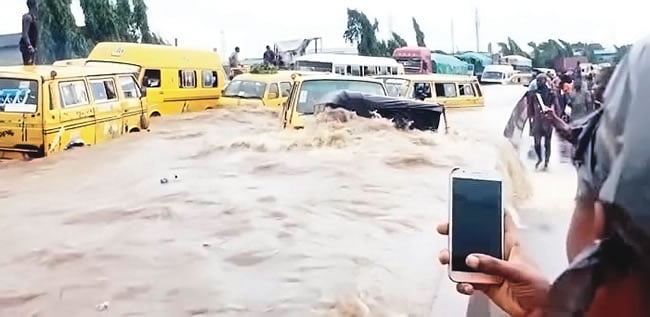
BOLA BADMUS, DAYO AYEYEMI, AKIN ADEWAKUN and SUBAIR MOHAMMED detail the flooding challenges confronting Lagos residents.
FOR residents of Lagos State, especially those in low-lying locations and waterfront communities, this is not the best of times, going by the floods that have covered their homes and roads after every heavy downpour in recent weeks. Apart from rainfalls, the latest fear in the metropolis is the release of rain water from Oyan Dam by the managers of the Ogun Oshun River Basin Development Authority, forcing affected families to resort to desperate measures in to survive without quitting their homes.
But the state government is advising that those asked to temporarily leave their abode should do so for their own safety. The state Commissioner for Information and Strategy, Mr Gbenga Omotoso, in an interview with Saturday Tribune, didn’t also rule out relocation of displaced residents, which is the main concern of those being asked to leave.
He said: “It (relocation) is advisory, and we always give that advisory whenever we see that there is the likelihood of flooding. We gave the same advisory last year and we also gave same advisory over a month ago, but the people are still there. We don’t pray for disasters but if anything untoward happens, the state has a machinery to contain disasters, to contain emergencies. All our emergency workers are there. LASEMA is alive, the Fire Brigade people are alive. In fact, they have just received 52 vehicles that Mr Governor is set to hand over, on Thursday, to them. And they have employed, like, 500 people who are firemen.
“So, should there be any emergency, the state is ready. And of course, there is a place around Igando where we keep people who may be displaced by any form of disaster. We have a place for them, but we hope it does not get to that stage. But what we have done is to give an advisory to people who are living in lowland areas; that they should move to upland areas so that we don’t have any casualty. We have a system to manage the situation, that we can press into service in a matter of seconds. We have emergency management agencies that are prepared for that kind of emergency, but we pray that we wouldn’t need them. I assure you that Lagos would not be caught unawares.”
The communities being referred to by the commissioner include Ketu, Alapere, Agric, Owode Onirin, Ajegunle, Alagbole, Kara, Isheri Olowora, Araromi Otun Orisha community, Agiliti, Maidan, Mile 12, Odo Ogun, Owode Elede, Agboyi 1, Agboyi II, Agboyi III. Already, houses have been submerged in these communities. While some residents have relocated pending when the water will subside, many said they have no place to go. As the state government is making efforts to prevent massive flooding of the metropolis by embarking on dredging and clearing of most drainages, it has been discovered that many houses are also on the setbacks of the drainages, making them susceptible to flooding. With the gradual release of rain water from Oyan Dam, residents’ fears have been aggravated as some streets have been taken over by water with valuables destroyed. Naturally, the state is located below the sea level and this has made its Lagoon the convergence point of all waters from the Ogun River, Ona Ibu River, Osun River and Sasha River that runs across many South-West states.
Desperate times
In Badagry, Saturday Tribune’s investigation showed that most residents are devising means to cope with the situation. Some have constructed wooden slabs which they place in their flooded apartments to sleep on while those who could afford concrete barricade constructed it at the entrance to prevent their homes from being submerged. An average slab is enough to accommodate a family of five.
The Chairman, Community Development Association, Badagry West Local Council Development Area, Alhaji Kolade Ogungbe, told Saturday Tribune in an interview that flooding is a perennial challenge confronting residents in the area. According to him, residents are annually displaced from their homes, just as schools, places of worship and community townhall are submerged across the LCDA. To cope with the challenge, Ogungbe stated that residents in flood-prone areas construct wooden slabs at the centre of their living room, on which they pass the night.
He said: “Flooding is an annual menace for many residents in Badagry. Whenever it rains, we are thrown in panic because our homes would definitely be affected. For instance, the entire Seme axis is always flooded at the slightest rainfall. In some areas, homes are submerged such that the occupants are forced to leave and seek shelter elsewhere.
“Our electronics and other household appliances are destroyed. We are gradually drifting into a crisis situation as far as flooding is concerned. And from what I have seen so far, it is beyond what the local government can handle. We want the Lagos State government to go beyond issuing advisory and do the needful.”
Ogungbe explained that the yearly flooding being experienced in Badagry is a direct result of absence of drainage channel.
“We want the government to construct drainage system and channel it straight to the lagoon. Our lives and livelihood are being affected negatively,” he said.
As flood fears rage, relocation or resettlement is a major issue for those who want to move to safety. For residents of Maidan Orile Patele, one of the flood-prone communities in Mile 12, Ketu, the government is perceived not to be sincere about its relocation advisory. Some of the residents who spoke to Saturday Tribune wanted the state government to roll up its sleeves and come up with measures that will permanently address the problem of flooding in the state.
Speaking about the disruption of social and economic activities in the community by floods, the Chairman, Victory Estate Community Development Association, Maidan Orile Patele, Mile 12, Ketu, Mr Ismail Abdulazeez Babatunde, compared the government’s relocation advisory to asking the “fish to move out of water.”
He described the issue of flooding in the area that occupies more than five hectares of the land as “an annual festival.” Residents, he added, have been surviving through self-help.
According to him, several entreaties have been made by the CDAs in the community to the state government regarding the plight of the people without any results.
“I think government is not being realistic and sincere about this advisory. Where do you want the people to go? While a few have actually relocated, most residents are still around, resorting to self-help,” he stated.
According to him, the recent collapse of the only pedestrian bridge built by the community has worsened the flood situation in the area since the bridge also served as a pathway for the water into the ocean.
He noted that replacing the bridge with a motorable one is one of the yet-to-be-answered requests of the community lying on the table of the state government in Alausa.
“We were in Alausa recently to remind the state government about this, but for now, no response,” the community head stated.
Babatunde however gave the assurance that the CDA would not throw in the towel. He expressed the determination of the association to mitigate the challenge and bring back socio-economic activities in the state.
Another resident, Bankole Michael, is also not thinking about relocation.
“Who will accommodate my three children, my wife and myself? How convenient is it to relocate? We have seen some of the people who made such a decision in the past. They are always worse off when they come back,” Michael said.
When reminded that the advisory was to prevent fatalities in the flood-prone areas, the father-of-three argued that moving out of one’s comfort zone could never be an option.
He however agreed that the flood is fast taking its toll on the community.
According to him, the younger ones have resorted to canoe business since every other commercial activity in the area has been grounded. He noted that the business is not without attendant risks too. A few days ago, according to him, some residents drowned on their way back to the community. He said the people could not find the pathway which the collapsed bridge had always provided and they got swept away after their canoe capsized.
“Moving around is difficult now because of the water. It is only the canoe business that is thriving in the community. But this is not without risks. Just a few days ago, we lost some residents. They were in a canoe coming back to the community and the canoe capsized,” he stated.
The community has also been thrown into darkness since the residents started experiencing flooding in the area.
“Ikeja Electric simply disconnected us and threw the whole community into darkness,” he stated.
Michael also expressed surprise that the water in the community had not receded yet, a development he attributed to the collapsed pedestrian bridge in the area.
“We had thought that the water would have receded, because in the past, by now, the thing would have gone down. But this is not the case,” he stated.
Unfortunately, life in the community without the pedestrian bridge has been stressful. According to Michael, people now resort to taking the long Owode route rather than Ketu to access the community.
“It has been really stressful, because the route is longer and costlier. But what do we do? Relocation can never be an option,” he stated.
Kept indoors by flood
Wading through the flood in Owode Onirin community, a resident who identified himself simply as Mr Idowu said that many residents and houses have been affected by the flood. He described the flood as an annual occurrence, saying that residents are used to it.
Mr Idowu narrated how the location has always been waterlogged throughout the year, pointing to the makeshift slabs that have been built by the residents to navigate the terrain. Apart from bored wells, a major source of water supply that have been submerged, he said residents now rely on water vendors and sachet water for drinking.
Another resident in Isheri North Estate, Mr. B. Bolaji, said water has taken over the entire government estate. According to him, many residents that could not wade through the flood did not go anywhere throughout the week. He explained that most of them have moved upstairs since the flood have taken over the ground floors of their apartments.
Just like residents of Owode Onirin, Bolaji said they also rely on vendors for the supply of drinking water.
Another resident in Isheri North, Olanrewaju Smith, said many residents have evacuated their homes due to flood that covered the entire roads and compounds. He explained that children and adults have to wade through flood to and from schools and workplaces. Olanrewaju said the flood has submerged the water facility in the area and called on the government to come to residents’ aid.
Disturbing numbers from NEMA
Distributing food items, clothing and other household materials to victims of flood, last week in Lagos, the National Emergency Management Agency (NEMA) said that based on it assessment, 24,131 households were affected by the flash floods while seven deaths were recorded in the state.
The Director-General of the agency, Alhaji Mustapha Ahmed, said that 920 houses were affected, 300 cultivated hectares of rice, cassava and yam farmlands were also submerged. Ahmed, who was represented by Dr Bandele Onimode, Director, Special Duties, further disclosed that livestock, including cattle, goats, turkey and pigs, were not spared.
ALSO READ FROM NIGERIAN TRIBUNE
Commenting on the flood disaster, former Head of Department of Urban and Regional Planning, University of Lagos, Dr Wale Alade, described flooding as natural when there is intense rainfall. According to him, increase in flooding in Nigeria is as a result of global climate change.
“We have extreme weather condition, extreme temperature at 40 and 50 degrees across the globe, and temperature below 0 degree. So, when you have high temperature, the Arctic regions or glacier regions are melting. As they are melting, the volume of water on the ocean and sea is increasing,” he said.
The university lecturer said that sea level rise coupled with intensive rainfall is responsible for flooding in Lagos. He pointed out that people would continue to complain because they have built in locations naturally reserved as flood plains.
“When you build in ecological sensitive areas, there is no way you won’t experience flooding. For example, Kogi State is a water catchment area. It is a confluence region where River Niger and River Benue meet and form a confluence. So, there is a lot of ecological sensitive areas in that location. So, when people build in ecological sensitive areas, they will naturally experience flood. That is where we should have reserved naturally as flood plains,” he said.
He also blamed the way the city is planned for the annual flooding, saying we refused to plan for resilience. According to him, “when we already knew that flood would come, we should have created channels for the water to flow.” To really combat the perennial massive flood, the associate professor suggested the deployment of technology, adding that all stakeholders should plan ahead. He encouraged the government to provide money for the planning of ecological-sensitive areas ahead of flooding. “We must anticipate and we must plan towards it,” Alade said.
Former President, Nigerian Institute of Town Planners, Mr Steve Onu, blamed flooding in some states on people’s actions and inactions. “Our actions as a result of non-adherence to planning regulations and our development patterns are anti-planning,” he said.
To make Nigeria’s cities resilient to disasters, he said that all stakeholders must embrace the UN -DRR elements for making cities resilient.
According to him, flooding is a natural disaster which could only be handled through planning measures. He described housing as one of the components of planning.
Why residents must relocate —Commissioner
The Lagos State Commissioner for Environment, Tunji Bello, asked residents of Ikoyi, Victoria Island, Lekki and other locations in Epe and Badagry to be wary of backlog from the Lagoon and be ready to evacuate at any time.
He said the warning was due to latest stakeholders’ critical evaluation that Lagos may be susceptible to dangers of flooding with the periodic release of rain water from Oyan Dam by the managers, the Ogun Osun River Basin Development Authority, to maintain the sanctity of the dam and which may increase the level of the water of the lagoon.
He said the state government convened a meeting of all critical stakeholders to evaluate the state’s preparedness for any eventuality over the ravaging massive flooding, adding that “the state has, however, directed all relevant enforcement arms of the state to step up their supervisory roles to contain any eventuality.”
According to him, the enforcement impact must be felt by recalcitrant people and institutions who have defied government and built structures on drainage alignments, flood plains and low-lying areas now more than ever before.
Despite the fact that Lagos is a coastal city with almost one third of its total landmass under water, the commissioner explained that what it experiences after each hour of heavy rainfalls is flash flooding which will recede a few hours after the cessation of such rainfalls.
He disclosed that the state, through the Office of Drainage Services and Water Resources, had embarked on massive dredging and cleaning of all primary and secondary collectors across the state.
As part of the efforts to ensure enforcement, Bello said that all structures on drainage set back would be removed.
On whether there is a relocation plan for affected residents, a director in the ministry said the resettlement camps in Igando and Epe are for short stay of between two weeks and one month.
WATCH TOP VIDEOS FROM NIGERIAN TRIBUNE TV
- Let’s Talk About SELF-AWARENESS
- Is Your Confidence Mistaken for Pride? Let’s talk about it
- Is Etiquette About Perfection…Or Just Not Being Rude?
- Top Psychologist Reveal 3 Signs You’re Struggling With Imposter Syndrome
- Do You Pick Up Work-Related Calls at Midnight or Never? Let’s Talk About Boundaries







